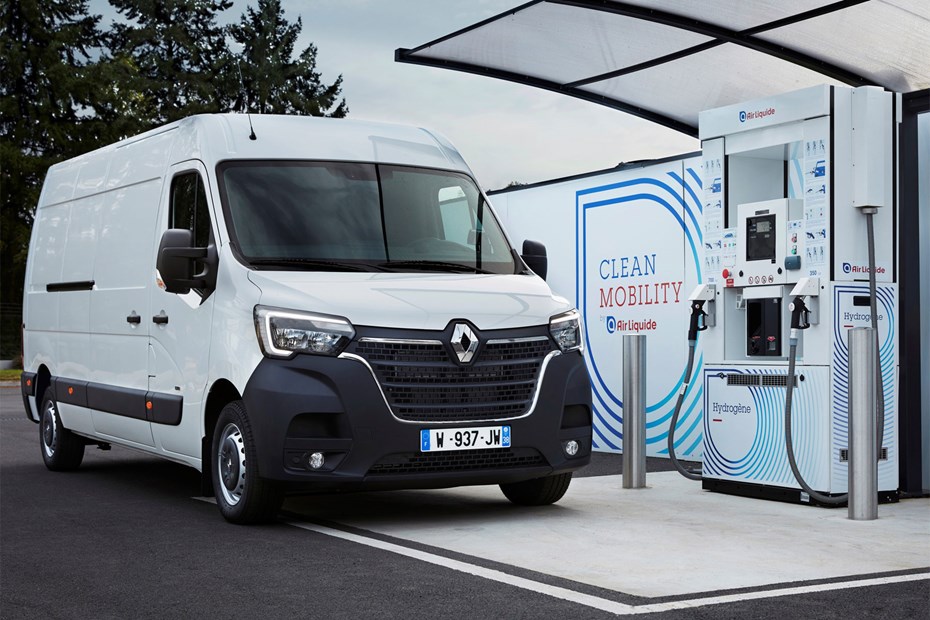If range anxiety is the major thing putting you off an electric van, Renault has just announced a solution – hydrogen-fuelled versions of the Kangoo ZE and the Master ZE with up to triple the claimed driving range and a much faster ‘charging’ time.
This is no joke. The Renault Kangoo ZE Hydrogen is set to go on sale before the end of 2019, with the Renault Master ZE Hydrogen following in 2020 – making them the first hydrogen vans available, ever.
You may want to brace yourself for the price, though, and you’ll need to live near a hydrogen filling station…
Wait – how can these be electric vans and hydrogen vans at the same time?
Just like their pure-electric counterparts, the only engine in these vans is the electric motor – which drives the wheels via a single-speed gearbox.
The difference is that in addition to the existing lithium ion battery packs, these vans carry hydrogen tanks and a 10kW fuel cell to create a chemical reaction with oxygen that then generates additional electricity to drive the motor for longer distances.
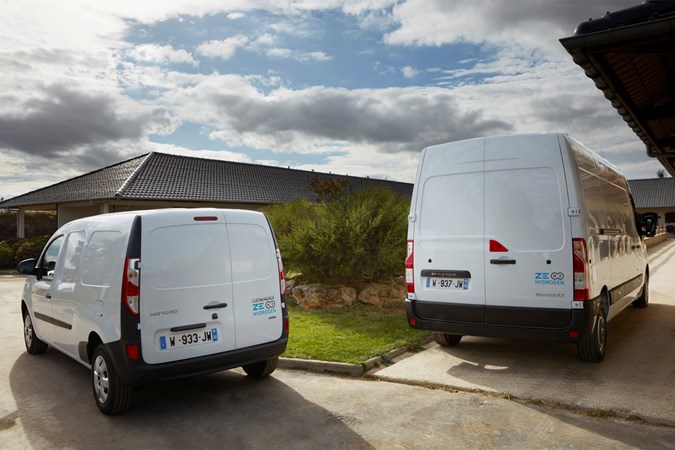
By using the fuel cell as an add-on to the existing electric drive system, Renault has created an unusual hydrogen range-extender set-up – in the same way that Ford uses a petrol engine to provide extra electricity for its Transit Custom Plug-In Hybrid.
Why is this a big deal?
Not only is hydrogen a very clean fuel – its only emissions in motion consist of water vapour, and the hydrogen can be sourced in eco-friendly ways, too – the amount you can store on board a van will take you much further than current battery technology can manage.
And with twin hydrogen tanks stored under the load area in the same way the batteries are, the load volume of the Master hydrogen vans – which will come in two panel van variants and two chassis cab variants – remains the same as the diesel versions.
The Kangoo’s load volume seems to drop ever so slightly, but it is a smaller van so there’s less room for the extra tech.
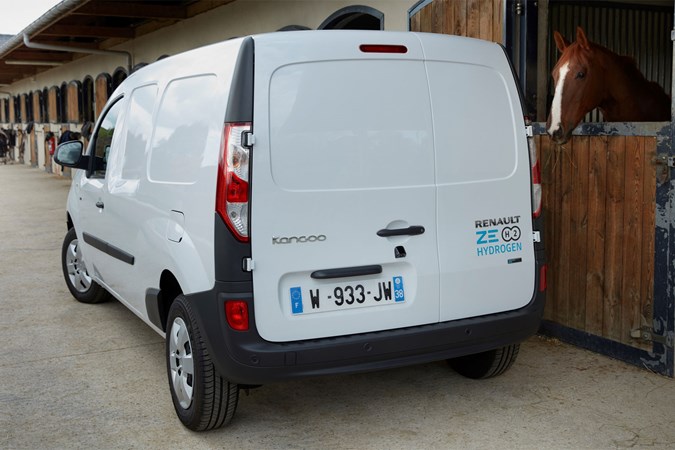
Anyway, you end up with ultra-low emissions vans that are as quiet and torquey to drive as pure electric models, but capable of travelling over 350km (that’s 217 miles) between fill-ups.
What’s more, filling a hydrogen tank is a much quicker process than conventional recharging, so you don’t have the inconvenience of being stuck at a plug socket for 40 minutes or more when the baterries are flat.
So what’s the driving range of the Renault hydrogen vans?
The Master ZE Hydrogen is quoted at 350km (217miles) – nearly three times the 120km (75 miles) optimistically available from the regular battery-power Master ZE.
The Kangoo ZE Hydrogen goes even further, to a quoted 370km (230 miles), but also has a better electric range in the first place of 230km (143 miles).
These figures are all to the recent WLTP testing standard, too – but are yet to be fully ratified.
How long does it take to fill the hydrogen tank?
Renault reckons 5-10 minutes – the variation probably depending on the pressure level of the hydrogen filling station and the size of the van.
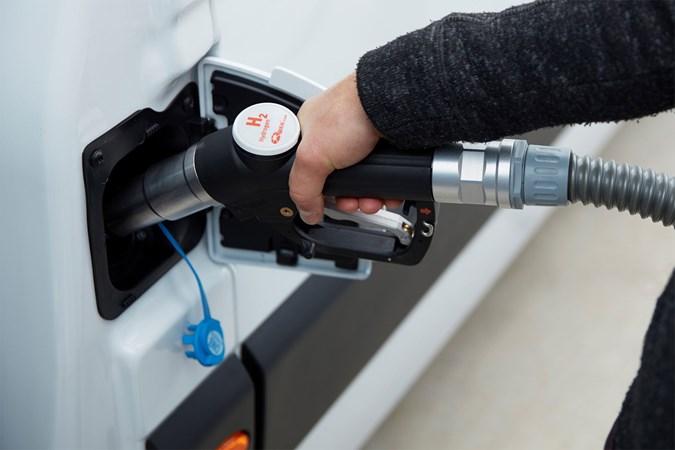
Certainly much closer to the time it takes to refuel with diesel than a regular electric van can manage.
Is this all Renault’s own work?
Renault’s developed the hydrogen technology in partnership with a company called Symbio, which is part of the Michelin Group.
What’s the catch?
There’s a weight penalty involved, which reduces the Master’s payload by 200kg and the Kangoo’s by 110kg.
More problematically, when was the last time you saw a hydrogen filling station? They do exist – but they are barely into double figures in the UK; there were 17 at the start of 2019, and not all of these are easily accessed by the public.
People also worry about the safety of hydrogen as fuel, but these systems are typically far more tightly controlled than petrol. No need to fret.
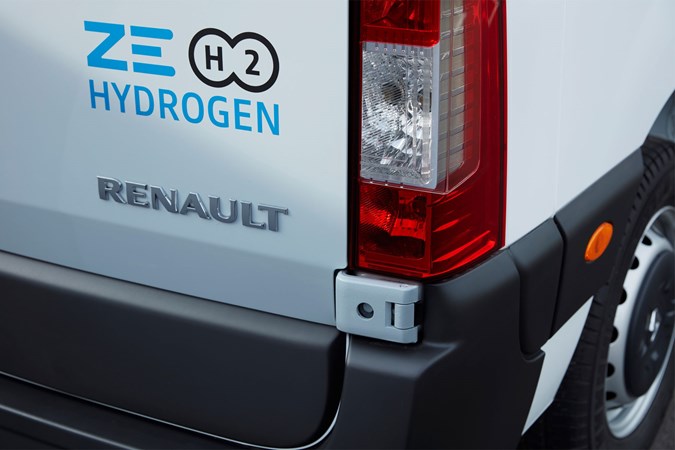
The very biggest issue of all, however, is that while the hydrogen itself isn’t especially expensive, the fuel cell technology that converts it into electricity is very pricey indeed.
How much will Renault’s hydrogen vans cost, and when do they go on sale?
Renault has not only said the Kangoo ZE Hydrogen will be available to buy before the end of the year, it’s even priced it for France already at 48,300 Euros – that’s plus tax but before of any government grants or incentives.
There’s no price for the Master ZE Hydrogen yet, but that’s set to be available in 2020, too.
It’s unclear at this stage whether you’ll be able to buy them in right-hand drive, but it is likely UK businesses that are particularly keen will be offered the chance to get left-hand drive versions – though exact UK pricing is still TBC.
Also read:
>> The Parkers guide to electric vans
Just so you know, we may receive a commission or other compensation from the links on this website - read why you should trust us.


